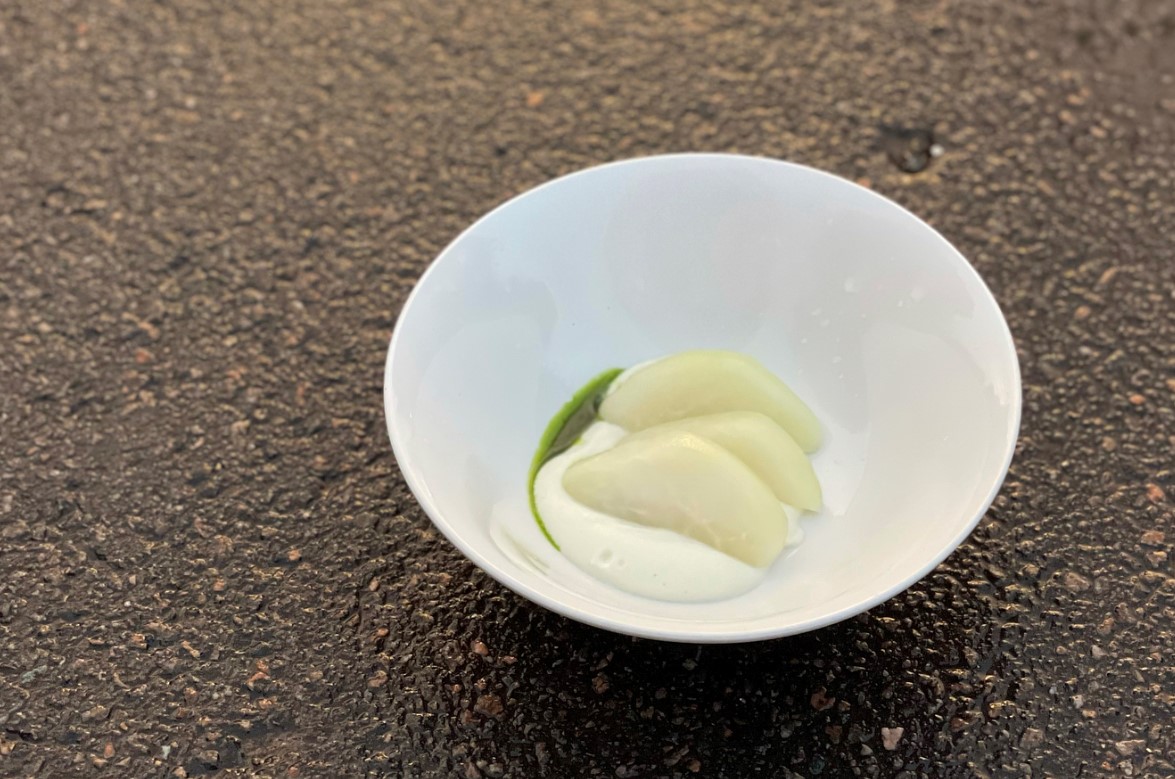The whole Kohlrabi with Balsam Fir Oil

There’s a small, overgrown quad trail in the Oyster Bed Bridge area of PEI. If you walk it long enough, you’ll eventually arrive at an old, abandoned fishing lodge. This is where this recipe came together.
I was sat down on a rocking chair outside the doorway — staring out at what was just weeks ago a sea of green, but is now a perfect mess of pastel colours. I admired the antithesis between the broken down cabin, and the thriving wild around it.
As I stepped off the front porch, I brushed my hand over a young fir that looked to be about 2 years old. You know when someone says, “woodsy” to describe a scent? I feel like that word was made for situations like this. The sweet, sharp, citrusy smell of conifer needles, mixed with the wet leaves and decomposing wood that lay around it, IS the smell of early fall… and all I wanted was to stay in that aroma forever. I gathered a small bag of this year’s new growth and carried on back the trail — head flooded with ideas on how to use them.
There’s this common misconception within home cooks that you need a ton of things on a plate in order for a dish to be complex, and not boring, when really, all you need is a few quality ingredients, mindful and precise seasoning, and a story to work off of.
If you step back and look at this dish, there are 3 main components. A perfectly handled vegetable, a slowly developed sauce, and a terroir driven oil. That’s it. You’ll quickly notice that each ingredient lays perfectly into the next, with flavours that move in harmony; and that work to connect us to the cabin that inspired most of my thoughts that day.
Take your time, be mindful, be precise, and prepare to surprise yourself and those that you choose to share this dish with!
Ingredients:
For the kohlrabi:
- 75 g kohlrabi (half of a head)
- 1 L filtered water
- 20 g young fir, pine, or spruce needles
- 250 mL white wine vinegar
- 1.25 g salt (or 1.5% by weight of kohlrabi)
- 10 g cold, unsalted butter
For the oil:
- 50 g young fir, pine, or spruce needles
- 100 g sunflower oil
For the sauce:
- 200 mL heavy cream
- 75 g kohlrabi (the other half of the head)
- 150 g sweet onion
- 3 g salt (or 1.5% by weight of kohlrabi and onion)
- 50 g cold, unsalted butter
Method:
The day before (or the morning of):
Begin by making your fir tea:
- Bring 1 L of water to a boil, then shut it off and drop in 20 g of your conifer needles.
- Allow to infuse (preferably overnight).
Make your conifer oil:
- Bring 1 L of water to a boil.
- Blanch conifer needles for 45 seconds, then transfer immediately to a bowl filled with ice water.
- Once cool to the touch, drain them of ALL of their water, and add them to a blender with 100 g sunflower oil.
- Blend on low until incorporated, gradually increasing the speed as you go.
- When you have a bright green puree, pour the mixture into a bowl or jar and refrigerate to infuse the flavour further (preferably overnight).
- Remove the mixture from the fridge and add it to a pan over low-medium heat. Simmer until you see the solids split away from the oil. It should look deeply green.
- Strain the oil through a coffee filter — allowing it to drip slowly and naturally to ensure a clear and clean final product.
- Freeze the oil for 2 hours. It’s ready to use.
Prep your kohlrabi:
- Peel your kohlrabi until you are left with a purely white surface.
- Dry roast (no oil, no salt) your skins in the oven at 400 degrees for 15 minutes or until deeply browned. Infuse in 250 mL of white wine vinegar and set aside (preferably overnight).
- Cut your kohlrabi in half. Dice one half to 1/2 inch pieces (for your sauce), and the other half into larger pieces to present (get creative — just ensure they’re all the same size).
The day of:
Make your sauce:
- Finely slice your sweet onion and put it in a bowl. Season with 0.5% of its weight in salt, and allow to sit and release a little of its juice.
- Add the onion and its juices to a pan with the diced kohlrabi and cook on low for at least 30 minutes, ensuring that they don’t get any colour (give it your full attention, stir it often, and do your best)
- When your onions and kohlrabi are broken down and soft, add in 200 mL of heavy cream.
- Allow time for the ingredients to merge their flavours together. About 15 minutes. (Time is an ingredient that we often forget about.)
- Transfer to a blender set to low, and gradually increase the speed as it gets smoother. Add in the reserved 0.5% salt and your 50 g of cold unsalted butter.
- Taste for seasoning (it should be fine), keep it warm and set it aside until you are ready to serve.
Cook the kohlrabi:
- Bring your conifer tea to a boil and set a resting rack on top of it.
- Season your kohlrabi with 0.5% of its weight in salt, taking care to ensure even distribution, and set it on the rack over the boiling water to steam and soften. It will capture the aroma of the fir tea and add an interesting depth and perspective to your final product!
- When softened (75% cooked), add your kohlrabi pieces to a bowl and season with the remaining 0.5% salt, a couple of tablespoons worth of your roasted kohlrabi skin vinegar, and 10 g of your cold, unsalted butter.
- Toss and mix until the butter is melted and you begin to see the liquids come together and glaze your kohlrabi (this is called emulsification). Taste and adjust for seasoning.
To the plate:
- Spoon a generous amount of your warm sauce into a bowl (trust me, you’ll want to drink it).
- Set a few pieces of your steamed kohlrabi on top, gently and with intention.
- Let a quarter teaspoon of your conifer oil slowly drip over your pure white sauce (you won’t need much) and embrace the extraordinary effort that you put into creating this minimalistic masterpiece!

About Nick Chindamo:
A Northern Ontario born chef, forager, and organic farmer, Nick Chindamo aims to bring his unique view of food to the forefront of Canadian cuisine through mindful approach, a zero-waste mentality, and his passion for storytelling.
Spending his days with hands in the rich, red soil of Heart Beet Organics on Prince Edward Island, Nick focusses deeply on what’s available here and now to create a weekly 8 seat, 10-20 course tasting menu that he runs out of an old barn at the back of the property. He sources everything that touches the plate himself from the farm that he works on, or the forests and coastline that surround it — and draws people into his world through multi-sensory exploration, extreme precision, and an incredible respect for the ingredient.
From eating carrots cooked in the soil that they came from, to experiencing what it feels like to set your cutlery aside in the middle of your 13th course for a group meditation, Nick’s approach to the culinary arts through philosophy, cultural tradition, and personal expression is ultimately driven by the power of connection.
